
Sci&Tech Writer Lauren Dicken explains the science behind CheekAge, a new technology which uses our epigenetic markers to reveal secrets about how we age
Ageing is one of life’s biggest mysteries: it involves nearly every cell in the human body, and yet it remains a confusing puzzle for even the best and brightest scientists. Why does the body slow down as we get older? And can we do anything about it? Epigenetics might provide some of the answers.
Lifestyle factors including stress, smoking, alcohol use and poor diet can accelerate ageing. These influences leave epigenetic marks on the genome, and it is these marks that help scientists develop ‘epigenetic clocks’, tools used to estimate biological age using DNA methylation patterns linked to ageing.
Lifestyle factors including stress, smoking, alcohol use and poor diet can accelerate ageing
Many of these epigenetic clocks have been created, but up until now they have required invasive blood tests. A team from Tally Health in New York have created a simpler method to work out biological age using only cheek cells. This represents a huge breakthrough in ageing and mortality research. CheekAge offers a personalised assessment of unique epigenetic patterns, instead of relying on generic statistics. Essentially this simple swab can reveal an individual’s biological state, all without a single drop of blood.
The CheekAge test analyses DNA taken from buccal (cheek) swabs to evaluate epigenetic changes, with a primary focus on DNA methylation patterns that occur with age. This test measures methylation at 200,000 locations in the genome which are associated with specific biological ageing processes. By investigating these patterns, CheekAge is able to estimate an individual’s biological age and compare it with their chronological age. An elevated biological age suggests accelerated ageing, typically correlating with a higher mortality risk, and an indication of declining health. The CheekAge test analyses DNA taken from buccal (cheek) swabs to evaluate epigenetic changes
CheekAge not only identifies general trends within ageing and mortality, but also considers the impact of a variety of lifestyle factors and specific health conditions. It uses a novel simulated annealing method.Binding complementary strands to form a double-stranded structure, combined with selecting and grouping CpG sites (in other words, regions of DNA which are rich in cytosine and guanine, two of the four DNA bases). This improves the accuracy of the test and adjusts for different factors, providing a more personalised result. A study of 1,500 people showed that CheekAge found a 21% increase in the risk of death for every standard deviation increase in its predicted biological age. CheekAge is more useful as a tool to track ageing and age-related diseases than chronological age and could offer a very useful method of tackling a significant number of age-related medical conditions.
So, what is the future for CheekAge? Dr Adiv Johnson, the head of scientific affairs and education at Tally Health, has high hopes for its potential. ‘Future studies are also needed to identify what other associations besides all-cause mortality can be captured with CheekAge,’ Dr Johnson suggested. ‘For example, other possible associations might include the incidence of various age-related diseases or the duration of “healthspan”, the period of healthy life free of age-related chronic disease and disability’. As well as being able to predict mortality, this innovation signals a huge leap in preventative healthcare, encouraging people to take initiative surrounding their health and lifestyle. A higher biological age might encourage more regular medical screenings or prompt healthier lifestyle choices and revolutionise the way health is perceived. Health is not merely about treatment, and preventative healthcare could be a huge area set to rise following next generation epigenetic clocks, such as CheekAge.
Enjoyed this article? Read more from Sci&Tech:
Hidden Visions: Colour Synaesthesia and Perception
Comments